英语八年级上册unit6教案
- 格式:doc
- 大小:15.59 KB
- 文档页数:9
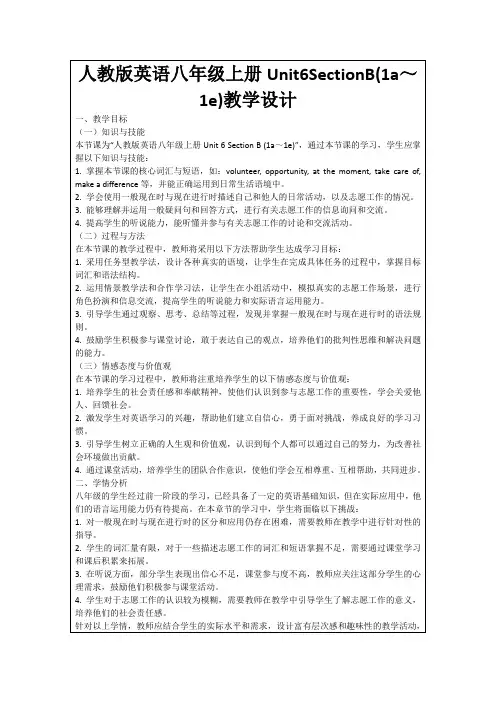
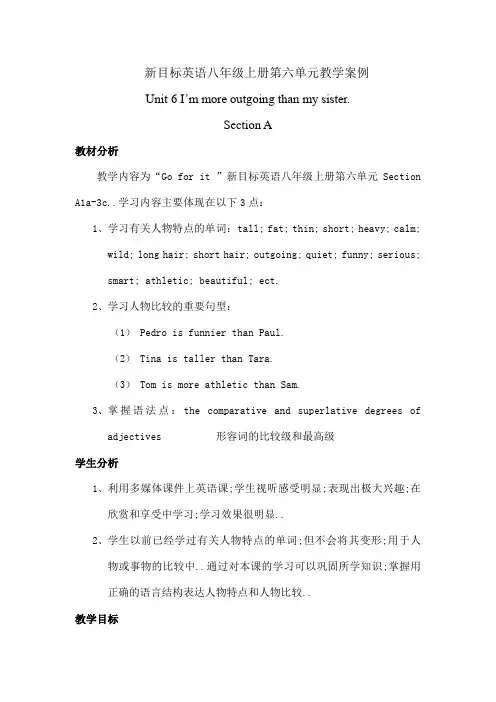
新目标英语八年级上册第六单元教学案例Unit 6 I’m more outgoing than my sister.Section A教材分析教学内容为“Go for it ”新目标英语八年级上册第六单元Section A1a-3c..学习内容主要体现在以下3点:1、学习有关人物特点的单词:tall; fat; thin; short; heavy; calm;wild; long hair; short hair; outgoing; quiet; funny; serious;smart; athletic; beautiful; ect.2、学习人物比较的重要句型:(1)Pedro is funnier than Paul.(2)Tina is taller than Tara.(3)Tom is more athletic than Sam.3、掌握语法点:the comparative and superlative degrees ofadjectives 形容词的比较级和最高级学生分析1、利用多媒体课件上英语课;学生视听感受明显;表现出极大兴趣;在欣赏和享受中学习;学习效果很明显..2、学生以前已经学过有关人物特点的单词;但不会将其变形;用于人物或事物的比较中..通过对本课的学习可以巩固所学知识;掌握用正确的语言结构表达人物特点和人物比较..教学目标本课以素质教育为目的;结合教材重点、难点及英语学科特点;利用多媒体辅助教学;从视、听、说等方面使学生得到锻炼;在愉快、轻松的氛围中温故而知新;达到初步运用英语交际的能力..1、谈论学生感兴趣的话题以及播放学生熟悉的人物图片;指导学生学习有关人物特点的单词、人物比较的表达及语法知识点“形容词的比较级和最高级”..2、通过学习本课;增强师生、生生间的相互了解和沟通..3、培养学生的口头表达能力、理解能力和提高学生听力水平..教学设计本节课的教学内容一共有五个部分:lead-in; words study; listening and speaking; comparison degree learning; homework.Step 1 Lead-in10minutes1.把全班学生分为四个小组;看哪个小组能说出最多的关于人物外貌或性格的形容词..teacher: Which group can tell me the adjective words形容词about appearance 外貌 and personalities 性格 as many as possible2.展示一些名人或有趣的相片;并和学生谈论他们的人物特点..1、复习已学内容;自然延伸到新课学习;起到承上启下的作用..2、开展竞赛活动;既可调动课堂气氛;又可提高学生求知欲望;一举两得..Step 2 words study5minutes在学生已掌握部分人物特点形容词的情况下;增加新的单词;扩充学生词汇量..Step 3 Listening and speaking15minutesI. Listening1、Listen to the tape and number the pictures in 1b.2、Listen to the tape and complete the chat in 2a. Listen againand fill in chat in 2b.3、Check the answers.听力训练既是对知识的巩固;也为下一步的任务输出提供了输入材料..II. speakingOne student describe one of classmates’characteristic or appearance and others try to guess who he/she is利用学生之间的熟悉程度让学生更容易表达人物特点;通过口头表达;纠正学生发音以及检验学生对比较级的掌握程度;通过生生之间的互动;增进学生之间的感情Step 4 comparison degree learning15minutes1展示相互比较的图片;让学生归纳规则单音节词及少数双音节词、多音节词比较级的构成形式..在课堂上让学生多动脑思考;养成其独立思考解决问题的习惯..2观看图片;学生口头回答关于形容词比较级的练习图文并茂;激发学生的学习兴趣;并且有利于加深学生课堂记忆Step 5Homework1、Do Workbook Exx.1-3.2、Preview Section B.教学材料备份此课堂是主要建立在利用多媒体教学设备进行教学的;作为教师不能是依靠多媒体;而应该是借助多媒体设备进行教学..所以教师应该考虑到设备可用性问题;在课前将教学材料备份..如:准备纸质相片以备ppt不能正常播放。
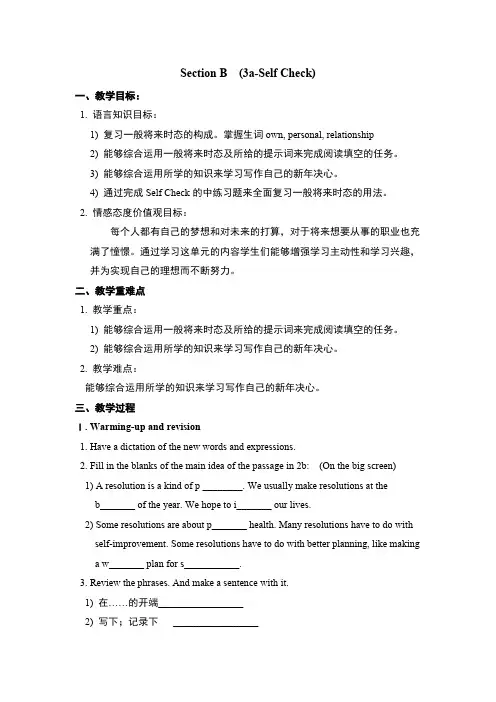
Section B (3a-Self Check)一、教学目标:1. 语言知识目标:1) 复习一般将来时态的构成。
掌握生词own, personal, relationship2) 能够综合运用一般将来时态及所给的提示词来完成阅读填空的任务。
3) 能够综合运用所学的知识来学习写作自己的新年决心。
4) 通过完成Self Check的中练习题来全面复习一般将来时态的用法。
2. 情感态度价值观目标:每个人都有自己的梦想和对未来的打算,对于将来想要从事的职业也充满了憧憬。
通过学习这单元的内容学生们能够增强学习主动性和学习兴趣,并为实现自己的理想而不断努力。
二、教学重难点1. 教学重点:1) 能够综合运用一般将来时态及所给的提示词来完成阅读填空的任务。
2) 能够综合运用所学的知识来学习写作自己的新年决心。
2. 教学难点:能够综合运用所学的知识来学习写作自己的新年决心。
三、教学过程Ⅰ. Warming-up and revision1. Have a dictation of the new words and expressions.2. Fill in the blanks of the main idea of the passage in 2b: (On the big screen)1) A resolution is a kind of p ________. We usually make resolutions at theb_______ of the year. We hope to i_______ our lives.2) Some resolutions are about p_______ health. Many resolutions have to do withself-improvement. Some resolutions have to do with better planning, like makinga w_______ plan for s___________.3. Review the phrases. And make a sentence with it.1) 在……的开端_________________2) 写下;记录下_________________3) 关于;与有关系_________________4) 学着做;开始做___________________5) 有相同之处________________6) 太……而不能________________7) 向某人许诺_____________8) 提高某人的生活___________Ⅱ. Lead-in1. Ask Ss about their New Year’s Resolutions:e.g. T: What’s your New Year’s Resolutions, Mary?Mary: I want to take up volleyball next term.T: Great! What about you, Jack?Jack:I’m going to make a soccer team. And we’re going to practice soccer every weekend.…2. Present some new words on the big screen. Explain them to the Ss. Ss try toremember them.own, personal, relationshipⅢ. Reading1. Tell Ss to work on 3a. Complete the first two paragraphs about resolutions withthe words in the box.2. 写作指导:首先,阅读方框中的词汇,掌握其意思,然后阅读短文,整体把握短文大意。
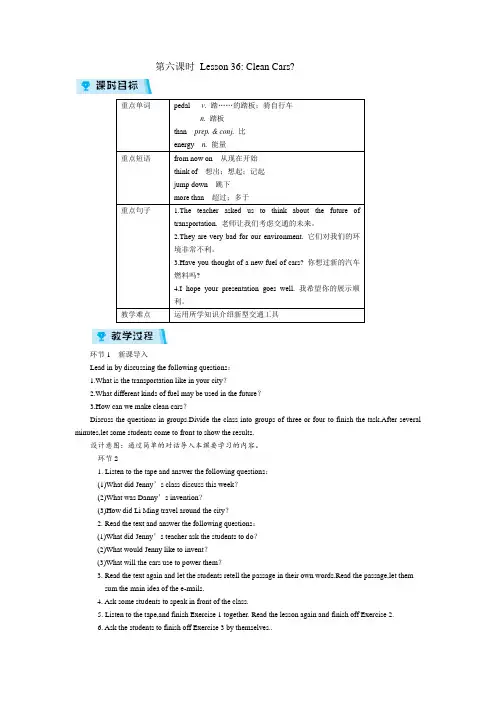
第六课时Lesson 36: Clean Cars?重点单词pedal v.踏……的踏板;骑自行车n. 踏板than prep. & conj.比energy n. 能量重点短语from now on 从现在开始think of 想出;想起;记起jump down 跳下more than 超过;多于重点句子 1.The teacher asked us to think about the future oftransportation. 老师让我们考虑交通的未来。
2.They are very bad for our environment. 它们对我们的环境非常不利。
3.Have you thought of a new fuel of cars? 你想过新的汽车燃料吗?4.I hope your presentation goes well. 我希望你的展示顺利。
教学难点运用所学知识介绍新型交通工具环节1 新课导入Lead in by discussing the following questions:1.What is the transportation like in your city?2.What different kinds of fuel may be used in the future?3.How can we make clean cars?Discuss the questions in groups.Divide the class into groups of three or four to finish the task.After several minutes,let some students come to front to show the results.设计意图:通过简单的对话导入本课要学习的内容。
环节21.Listen to the tape and answer the following questions:(1)What did Jenny’s class discuss this week?(2)What was Danny’s invention?(3)How did Li Ming travel around the city?2. Read the text and answer the following questions:(1)What did Jenny’s teacher ask the students to do?(2)What would Jenny like to invent?(3)What will the cars use to power them?3. Read the text again and let the students retell the passage in their own words.Read the passage,let themsum the main idea of the e-mails.4. Ask some students to speak in front of the class.5. Listen to the tape,and finish Exercise 1 together. Read the lesson again and finish off Exercise 2.6. Ask the students to finish off Exercise 3 by themselves..7. Finish off Exercise 4 in “Let’s Do It!”.设计意图:让学生能抓住文中重点词汇和句型,熟读记忆。
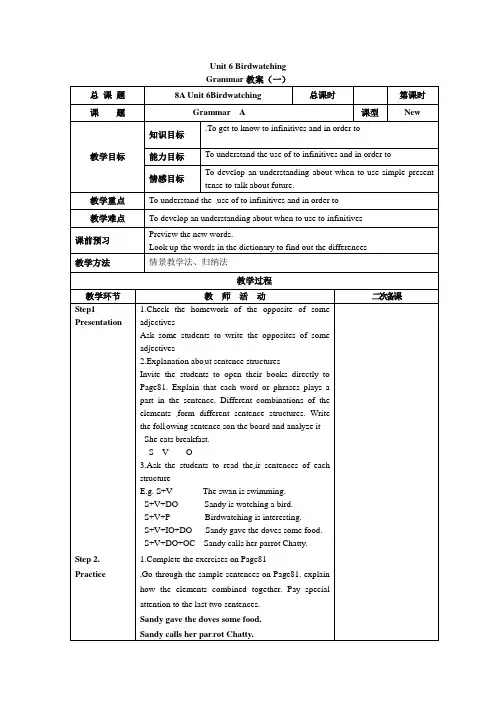
Unit 6 BirdwatchingGrammar教案(一)总课题8A Unit 6Birdwatching 总课时第课时课题Grammar A 课型New教学目标知识目标.To get to know to infinitives and in order to能力目标To understand the use of to infinitives and in order to情感目标To develop an understanding about when to use simple presenttense to talk about future.教学重点To understand the use of to infinitives and in order to教学难点To develop an understanding about when to use to infinitives课前预习Preview the new words.Look up the words in the dictionary to find out the differences教学方法情景教学法、归纳法教学过程教学环节教师活动二次备课Step1 PresentationStep 2. Practice 1.Check the homework of the opposite of some adjectivesAsk some students to write the opposites of some adjectives2.Explanation abo ut sentence structuresInvite the students to open their books directly to Page81. Explain that each word or phrases plays a part in the sentence. Different combinations of the elements form different sentence structures. Write the foll owing sentence son the board and analyze it She eats breakfast.S V O3.Ask the students to read the ir sentences of each structureE.g. S+V The swan is swimming.S+V+DO Sandy is watching a bird.S+V+P Birdwatching is interesting.S+V+IO+DO Sandy gave the doves some food. S+V+DO+OC Sandy calls her parrot Chatty.plete the exercises on Page81Go through the sample sentences on Page81. explain how the elements combined together. Pay special attention to the last two sentences.Sandy gave the doves some food.Sandy calls her par rot Chatty.Step 3. PresentationStep4. ProductionStep5. Homework 2. Make some sentences a ccording to the former part of the unit and get them to analyze.3. Show another group of sentences and get the studen ts to decide the sentence str ucture.1. Have a free talk and elicit the use of simple present, talking about programmers, timetable, calendars .2. Talk about the schedule for tomorrow with simple present tense.1. (Organizing a school trip)Talk about the timetable on Page82. Complete the notes on Page 83 using the simple present tense of verbs in brackets.2.Talk about the schedule using simple present tenseTIME ACTIVITIES6:30 The first underground leaves8:00-10:00 Give lessons to Class1 and Class2 11:00 Meet my friends from Xiamen12:00 Have lunch with my friends13:00 Return to school13:30 Have a meeting16:00 Meet some parents in the office 19:00 Watch Ji XiaolanFill the bla nks with proper forms of the given verbs according to the schedule.3. Make a summary to the use of simple present tense.1. Recite the note about organizing a school trip on Page83.2. Complete the relative exercises.3. Make five more sentences according to the sentence structures.4. Preview Grammar C教学反思Grammar教案(二)教学内容8Aunit6 Birdwatching Grammar 二次备课教学目标1. To use to-infinitives for pu rpose2. To learn to use verbs+objectives+to-infinitives重点难点Key points:To use to-infinitives for purposeDifficult points:To learn to use verbs+objectives+to-inf initives教学流程设计教学流程设计Step1.Lead-in (guessing)Step2.Finding rules and fill in the table.1.Teacher let students say which syntax-function the underline parts play.2.Students answer and fill i n the following table in group. Step3.Presentation1. Use to-infinitives for purposee.g.He sat dow n to have a rest.Ask Ss to give more examples.2.Tell Ss that we can use in orde r to to expres s purpose.This is more formal than usi ng to-infinitives.Ask Ss to change the sentences with in order to.People go to Zhalong in order to watch the birds.They should read abou the bird first in order to learn more about them.ing verbs+objects+to-i nfinitives不定式做宾语补足语Show the Ss more examples :The policeman asked the boys not to play football on the road. The teacher told me to come to school earlier next time.Ask the Ss to find more verbs that can be used in this way. The teacher asked him to speak louder.I notice her enter the roo m:Have a summary吾(五)看(see. watch.notice.observe.look at)三室(使)(let.make.have),两厅(听)(hear.listen to),一感觉feel,不太土toStep4 ProductionAsk the Ss to finish exercisesStep5 Homework课题Unit 6 Grammar 课时课型新课教学目标1.To master the constructions of to-infinitives for purpose and verbs+objects +to-infinitives.2.To understand and use them correctly.重、难点1.To master the constructions of to-infinitives for purpose and verbs+objects +to-infinitives.2.To understand and use them correctly.教学设计详案二次备课内容Step1. Show learning aims. (1')Step2. Guide students to learn and understand the construction of to-infinitives for purpose.1.Read the following sentences and say about to-infinitives in them.(3')(1).When she was six months old, she began to eat bamboo.(2).Please remember to bring your homework tomorrow.(3).We hope to get good grades in this midterm exam.(4).I often go to the market to watch the birds.(5).Now the Chinese government has made laws to prevent all these things.T says: 动词不定式不仅可以位于某些动词后做其宾语,如:(1).(2).(3),而且可以作目的状语。
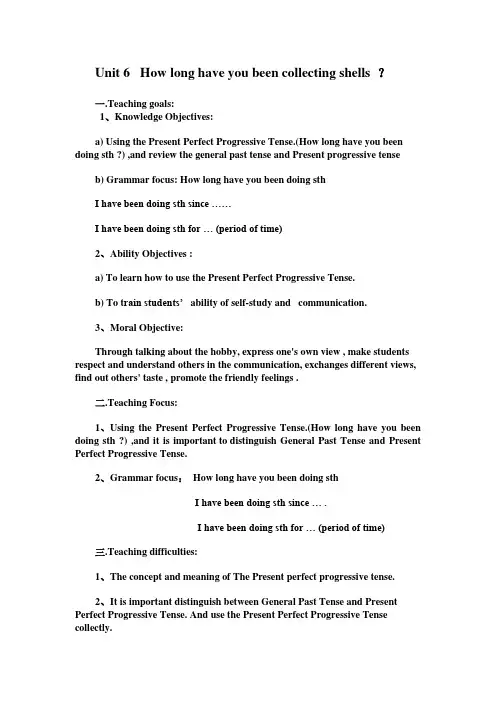
Unit 6 How long have you been collecting shells ?一.Teaching goals:1、Knowledge Objectives:a) Using the Present Perfect Progressive Tense.(How long have you been doing sth ?) ,and review the general past tense and Present progressive tenseb) Grammar focus: How long have you been doing sthI have been doing sth since ……I have been doing sth for … (period of time)2、Ability Objectives :a) To learn how to use the Present Perfect Progressive Tense.b) To t rain students’ability of self-study and communication.3、Moral Objective:Through talking about the hobby, express one's own view , make students respect and understand others in the communication, exchanges different views, find out others' taste , promote the friendly feelings .二.Teaching Focus:1、Using the Present Perfect Progressive Tense.(How long have you been doing sth ?) ,and it is important to distinguish General Past Tense and Present Perfect Progressive Tense.2、Grammar focus:How long have you been doing sthI have been doing sth since … .I have been doing sth for … (period of time)三.Teaching difficulties:1、The concept and meaning of The Present perfect progressive tense.2、It is important distinguish between General Past Tense and Present Perfect Progressive Tense. And use the Present Perfect Progressive Tense collectly.四.Teaching Methods: speaking ,exercise,listening, reading五.Teaching Time : the Second Period六.Teaching ProceduresStep1leading in the new class by introducing myself .1、I am a young teacher .I started to teach English in 2004.In this unit we are going to talk about how long we have been doing things,You can ask the teacher: How long have you been teaching English ?I have been teaching English for 7 years or I have beenteaching English since 2004.2、Ask students when did you study English? In which year?Are you studying English now ?How long have you been studying English ?I have been studying English for ( ) years.I have been studying English since ( ).Step2 Read and translate.Step3 Fill in the blanks.Step4Conclusion.Step5 Make conversations in pairs.Step6 Guessing game: who is he ?step 7 To learn how to use the Present Perfect Progressive Tense by reading.Step8 Fill in the blanks using “for” and “since” and explain the“since ”“and for”.Step 9 Distinguish General Past Tense and Present Perfect Progressive Tense.Step 10 Play the recording and get Ss to fill in the chart . Correct the answers .Step 11 In pairs ,get the students to ask and answer .Then ask some to do a survey and make a report.Step 12. Do a writing about Chenlong.Step 13. Summary.七、Homework1、Review the vocabulary2、Review the Present Perfect Progressive Tense.。
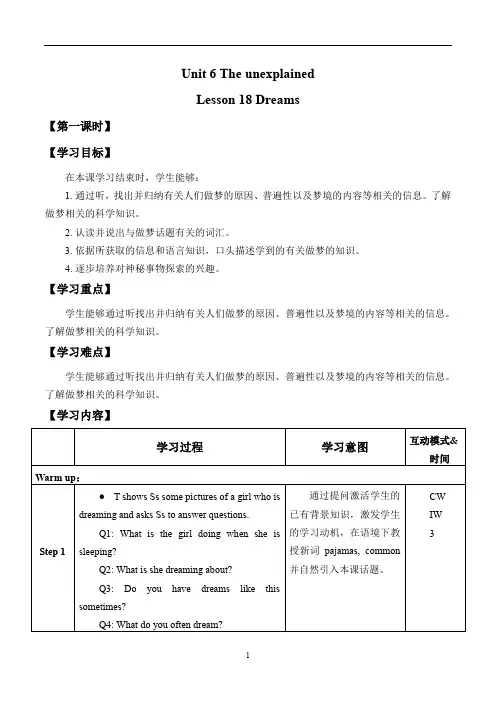
Unit 6 The unexplained
Lesson 18 Dreams
【第一课时】
【学习目标】
在本课学习结束时,学生能够:
1.通过听,找出并归纳有关人们做梦的原因、普遍性以及梦境的内容等相关的信息。
了解做梦相关的科学知识。
2.认读并说出与做梦话题有关的词汇。
3.依据所获取的信息和语言知识,口头描述学到的有关做梦的知识。
4.逐步培养对神秘事物探索的兴趣。
【学习重点】
学生能够通过听找出并归纳有关人们做梦的原因、普遍性以及梦境的内容等相关的信息。
了解做梦相关的科学知识。
【学习难点】
学生能够通过听找出并归纳有关人们做梦的原因、普遍性以及梦境的内容等相关的信息。
了解做梦相关的科学知识。
【学习内容】。
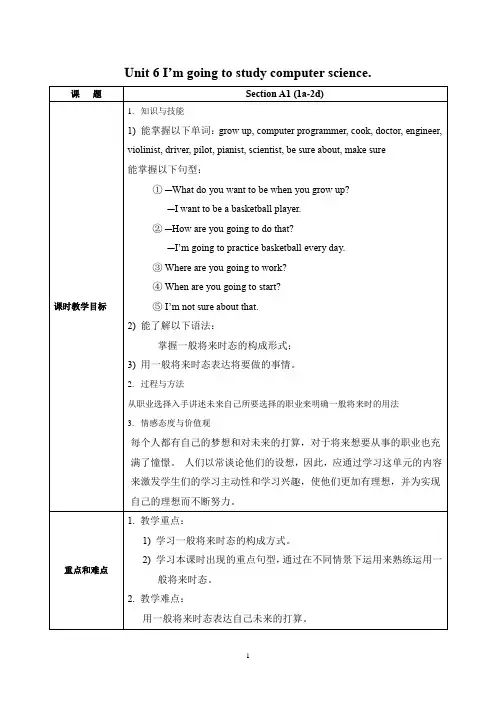
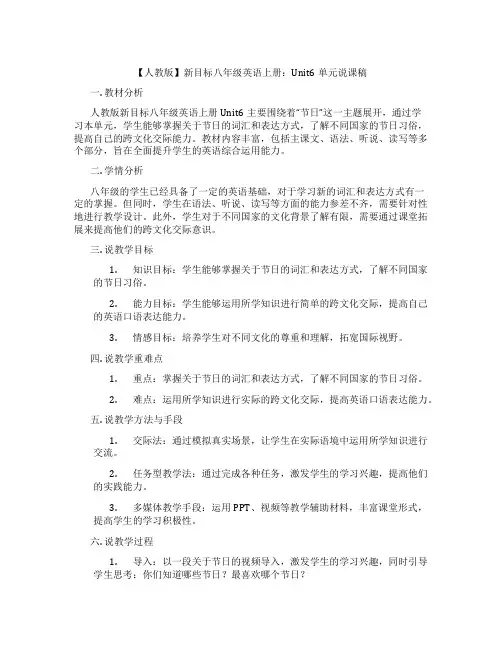
【人教版】新目标八年级英语上册:Unit6单元说课稿一. 教材分析人教版新目标八年级英语上册Unit6主要围绕着“节日”这一主题展开,通过学习本单元,学生能够掌握关于节日的词汇和表达方式,了解不同国家的节日习俗,提高自己的跨文化交际能力。
教材内容丰富,包括主课文、语法、听说、读写等多个部分,旨在全面提升学生的英语综合运用能力。
二. 学情分析八年级的学生已经具备了一定的英语基础,对于学习新的词汇和表达方式有一定的掌握。
但同时,学生在语法、听说、读写等方面的能力参差不齐,需要针对性地进行教学设计。
此外,学生对于不同国家的文化背景了解有限,需要通过课堂拓展来提高他们的跨文化交际意识。
三. 说教学目标1.知识目标:学生能够掌握关于节日的词汇和表达方式,了解不同国家的节日习俗。
2.能力目标:学生能够运用所学知识进行简单的跨文化交际,提高自己的英语口语表达能力。
3.情感目标:培养学生对不同文化的尊重和理解,拓宽国际视野。
四. 说教学重难点1.重点:掌握关于节日的词汇和表达方式,了解不同国家的节日习俗。
2.难点:运用所学知识进行实际的跨文化交际,提高英语口语表达能力。
五. 说教学方法与手段1.交际法:通过模拟真实场景,让学生在实际语境中运用所学知识进行交流。
2.任务型教学法:通过完成各种任务,激发学生的学习兴趣,提高他们的实践能力。
3.多媒体教学手段:运用PPT、视频等教学辅助材料,丰富课堂形式,提高学生的学习积极性。
六. 说教学过程1.导入:以一段关于节日的视频导入,激发学生的学习兴趣,同时引导学生思考:你们知道哪些节日?最喜欢哪个节日?2.新课呈现:通过PPT展示本节课的主要内容,包括节日词汇和表达方式,不同国家的节日习俗等。
3.课堂实践:模拟真实场景,让学生分组进行角色扮演,运用所学知识进行跨文化交际。
4.语法讲解:针对本节课的语法点,进行详细的讲解和示例,让学生在理解的基础上进行运用。
5.听力训练:播放一段关于节日的听力材料,学生听后进行问答,检查学生对听力材料的理解程度。
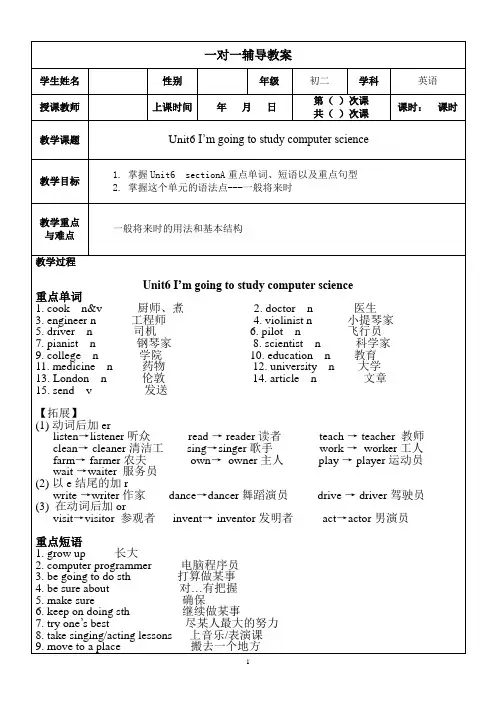
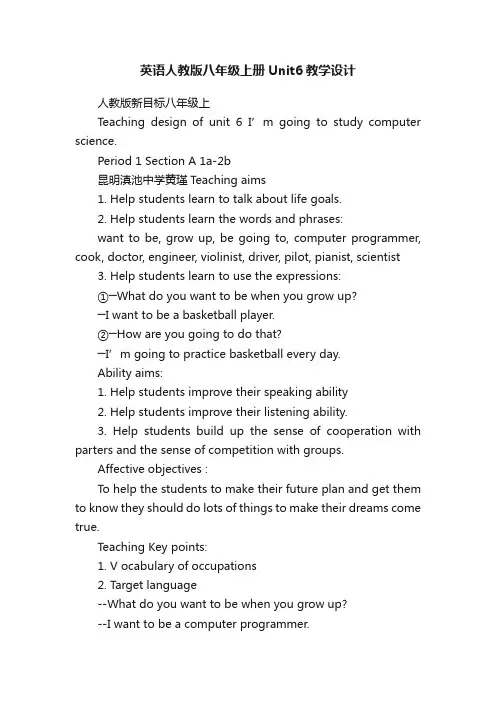
英语人教版八年级上册Unit6教学设计人教版新目标八年级上Teaching design of unit 6 I’m going to study computer science.Period 1 Section A 1a-2b昆明滇池中学黄瑾T eaching aims1. Help students learn to talk about life goals.2. Help students learn the words and phrases:want to be, grow up, be going to, computer programmer, cook, doctor, engineer, violinist, driver, pilot, pianist, scientist3. Help students learn to use the expressions:①─What do you want to be when yo u grow up?─I want to be a basketball player.②─How are you going to do that?─I’m going to practice basketball every day.Ability aims:1. Help students improve their speaking ability2. Help students improve their listening ability.3. Help students build up the sense of cooperation with parters and the sense of competition with groups.Affective objectives :To help the students to make their future plan and get them to know they should do lots of things to make their dreams come true.Teaching Key points:1. V ocabulary of occupations2. Target language--What do you want to be when you grow up?--I want to be a computer programmer.--How are you going to do that?--I’m going to study computer science.3.Structures Future with going to, Want to be, What, Howquestions4.Grammar The simple future tense.Teaching Difficulties :1.How to name different kinds of occupations. Such asmagician, pianist, waitress2.According to students life goals, how to talk about variousfuture intensions by using “be going to ‘.Teaching Subject: Students in Grade EightTeaching Method: Communicative approach, Pair work, Group workTeaching Materials: PPT, student’s handout ,a projector Teaching Time: 40 minutesTeaching procedures:Step 1 Warming up and lead in (3mins)1. Greetings2. Play a game called EngineerStep 2 Present the vocabulary of occupation (3 mins)1.Present the words of 16 kinds of jobs ,lead students to read them.2. Read the words together and make a summary for the jobs3. A quick eye game.Step 3 New language presentation. (4mins)1. Explain the meaning of grow up2. Present the target languageTeacher use famous people’s pictures to help students learn to use the target language.─ What do you want to be when you grow up?─ I want to be a basketball player.3. Ask and Answer by using the target language.4. Lead students to read the target language together.Step 5 Pair work and Group competition (7mins)Teacher will divide the class into four groups. Which group can ask and answer the target language with the shortest time will be the winner.Step 6 New language presentation. (4mins)Lead in new target language─How are you going to do that?─I’m going to practice basketball every day.Teacher encourage students to think and say how are they going to achieve their dream by using be going to.Step 7 1c Pair work (2mins)Step 8 1b Listening practice (3mins)Listen and fill in the blanks. Then match the itemsStep 9 New language presentation.(2mins)--Where are you going to work ?--I’m going to work in S hanghai.Step 11 2a Listening practice (3mins)Listen . What are Cheng Han’s plans for the future? Fill in the chart Step 12 Let’s talk about our dreams.(2mins) Teacher show the funny pictures of students .Students try to say their life goals and their plans with the target languages.Step 13 Writing our dreams jobs (6mins)Teacher will lead student to write down their dreams jobs by asking three guided questions. Then teacher will play a piece of music. Students are supposed to finish their life goals when the music is over. Teacher will invite one student to write down her sentences on the blackboard and invite the other student readher sentences. The rest students can listen and help the two students to correct their writing.Step 14 Make a summary for the class.Step 15 Choose the group winnerStep 16 Share an old say “Where is the will , there’s the way”Step 17 HomeworkBlackboard designUnit 6 I’m going to study computer science.A:What do you want to be when you grow up?B:I want to be a computer programmer.A:How are you going to do that?B:I’m going to study computer science.。
Unit 6 I’m going to study computer scienceSectionA Grammar Focus-3c教案设计一、教学目标1、be going to 构成的一般将来时态的用法。
2、对职业提问的表达方式。
3、时间状语从句中的一般将来时态的特别用法。
二、教学重难点重点:1、be going to 构成的一般将来时态的用法。
2、条件状语从句和时间状语从句中的一般现在时态的特殊用法。
3、掌握动词send的用法。
难点:1、用英语进行口语交际的能力。
2、口语表达带有个性观点的句型。
三、教学设计Step1 Lead-in1.向学生展示名人的成功经历,让学生自由讨论各种职业的特征。
2.学生就自己未来的梦想职业和工作进行对话交流。
3.用幻灯展示各种职业的图片和英语词汇。
Step2 Presentation1.在幻灯片上展示P43 Grammar Focus的句子,和学生一起练习一般将来时态在句子中的正确运用。
2.重点讲解一般将来时态的用法,认真学习want to be 与be going to 之间的联系。
3.任务:语言运用,完成教材P43 Activity 3a的练习。
Step 3 Drill任务:补全对话Complete the Conversations,在幻灯片上展示对话,学生完成练习。
Step4 Practice1.让学生分成小组进行对话交流练习。
2.补全对话。
Step5 Summary本节课主要学习了一般将来时态在特殊疑问句、一般疑问句和陈述句中的不同用法,与want to do 结构联系在一起学习。
Step 6 Homework1.对自己未来的理想职业工作方向,写一片英语短文。
2.补全句子。
(1)你能给你父母寄一封信吗?Could you please send a letter ____your parents?send sb. sth =send sth. to sb.给某人寄某物(2)她的愿望是当一名厨师。
Unit 6 I’m going to study computer science教材解读本单元以“What do you want to be when you grow up?”引出话题,谈论人们将要做什么,使学生们学会如何了解或表述将来的一种状态,正确使用be going to do 结构。
重点掌握和运用“What do you want to be when you grow up?” “How are you going to do that?及其答语和相关的词汇、句型。
单元目标一、知识与技能1. 了解并掌握be going to do的用法,掌握重点句型:What do you want to be when you grow up? How are you going to do that? 和答语。
2. 语言技能目标:能用be going to do 的各种形式进行准确的描述和表达将要发生的动作;通过情景中的操练培养学生的发散思维能力,激发学生的想象力,培养学生的语言交际能力;能够用自己在本单元中所学的语言内容与笔友进行对话与通信。
二、过程与方法通过听、说、读、写等任务型活动,熟练应用词汇和句型。
三、情感、态度与价值观通过对话互动,激发学生英语学习的兴趣,增进相互之间的了解,提高运用英语的能力,而且通过让学生描述自己对将来的打算,促使他们树立健康、积极的生活目标。
教法导航采用情景法、交际法及任务型教学途径并配以多媒体辅助教学。
通过设疑、提问、启发、诱导等方法,唤醒全体学生的主体意识,从而调动学生的积极性,让学生处于积极思维状态之中,全方位,多角度培养学生运用语言的能力。
学法导航进行听、说、读、写操练,使整个教学从知识的内化到外显呈现出一种动态、和谐的发展过程。
课时支配第1课时:Section A 1a-2c第2课时:Section A 2d-3c第3课时:Section B 1a-2e第4课时:Section B 3a-Self Check教案Ⅰ第1课时Section A 1a-2d教学目标一、知识与技能1. 掌握重点词汇:grow up, computer programmer, cook, doctor, engineer, violinist, driver, pilot, pianist, scientist, be sure about, make sure2.能掌握以下句型:─What do you want to be when you grow up?─I want to be a basketball player.─How are you going to do that?─I’m going to practice basketball every day.─Where are you going to work?─When are you going to start?─I’m not sure about that.3. 能运用所学的知识,描述人们将要做的事情。
Unit 6 I’m going to study computerscience.Section B教学设计Period 1 1a-1c教材分析本部分1a-1e是听说课,围绕“新年计划(New Year’s resolutions)”话题展开,语言输入量多。
它是学生对Section A中所学知识的巩固,拓展与提升运用。
1a-1b通过图文匹配和对话练习帮助学生复习谈论自己将来的打算。
1a 中出现的短语时Section A 中从未出现过的,他们为后面1c-1d的听力材料的呈现提供词汇储备。
1c-1d以“谈论新年计划”为话题展开听力练习,自然贴切地运用1a中刚学地词组,能让学生进一步体会目标语言在真实语境中地运用,1e时一个两人地问答活动,学生可以自行组织对话,灵活度大。
教学目标1.能掌握以下单词:resolution,team,foreign2.能掌握一下句式结构:(l) -What are you going to do next year?-What are you going to do next year?-I’m going to take guitar lessons.(2) My New Year’s resolution is to get good grades.3. 能用所学语言结构谈论自己的新年计划。
教学重难点重点:掌握本课时出现的生词及表达方式;巩固Section A所学语言结构,丰富与学习相关的话题词汇难点:进行听力训练,以听促说,提高综合听说能力。
课前准备1.了解学生是否制定过新年计划;2.制作多媒体课件及学案教学过程Step l: Lead-in1.Brainstorm:Ask students to talk about the jobs they know:teacher, nurse, doctor, actor, actress, runner, basketball player, pilot, waiter, computer programmer pianist, scientist, violinist.学生们可以小组为单位进行比赛,看谁写出来的最多(在五分钟内)2.Then get them to share what they want to be when they grow up.e. g. I want to be an engineer. I’m going to study math.【设计意图】通过让学生说出表职业的名词,以及说出他们的理想及打算如何去做,激起学生已有的学习经验,导入本节课话题。
Unit6 SectionB(3a-Self Check)教案【教材版本与册数】新目标人教版八年级上册【单元名称】Unit6 I’m going to study computer science.【课时】SectionB 3a-Self Check (第5课时)【课型】Writing ( 写作课)教材分析本课时内容是人教版新目标初中英语教材8上Unit 6第5课时,该单元话题是“Life goals”, 功能是“Talk about pfuture intentions",此节课型定位为以话题为核心的“写作课型”。
本单元Section B写作课部分在前面听说读的基础上,让学生在语言技能上通过复习词汇和操练重点句型,为写作做好铺垫。
从3a填词到3c写句子,再到3c完整语篇输出的活动设计,由易到难,循序渐进,符合学生写作发展和对事物的认知规律。
在策略上,通过提供材料并仿照练习,让学生用所学的目标语言来描述事物或事件并表达一定的思想,展开对计划或者愿望的写作,并且要培养学生的写作技能。
在情感态度上,通过活动4对该话题展开深入讨论,提升高度,规划自己生活的城市,增进学生了解家乡、热爱家乡的情感。
语言知识目标:1.通过教师复习、整合整个单元知识要点,形成体系。
并学习三个新单词own, personal, relationship学习能力:2.能够综合运用所学的知识来学习写作自己的新年决心。
1 / 6第 1 页教学目标 3.养成好的作文习惯,学习作文技能。
学习策略:4.通过完成Self check的中练习题来全面复习一般将来时态的用法。
情感态度价值观目标:通过学习这一课,引导学生确立理想职业,并为之奋斗,做坚持梦想的人。
教学重难点教学重点:1.复习本单元目标词汇及句型。
2.学会写作:学习写作技巧,语言组织能力。
教学难点:1.对学生写作能力及技巧的培养。
2.运用want to do/be going to do 表达将来的打算。
英语八年级上册unit6教案
Write about an event that you remember well .Give dates and
say why you remember it ,and what you were doing at the time
when you heard the news .一起看看英语八年级上册unit6教案!
欢迎查阅!
英语八年级上册unit6教案1
课前准备:
教师:录音机,所学物品的图片。
学生:英语点金教练及相关的学习用具
Teaching procedures(教学步骤):
Step 1 Leading in(导入话题,激活背景知识)
1.Greetings and free-talk .
2.Check the Homework(家庭作业) .
Step 2 Pre-task(任务前活动)SB Page 24 , Groupwork .
1.Arrange the Ss in small groups .Ask them to look at the
pictures and talk about the events .Encourage students to say how
historical events affected their lives .
2.Tell the Ss to help each other with vocabulary they might
need and don’t know .
Step 3 While-task(任务中活动)
1.Reading strategy :The title can be helpful for you to
understand a text .It is also a good idea to read the first sentence of
each paragraph before reading .
2.Read the title ,which gives an indication of the content of the
reading .Think of one question they think might be answered in the
reading .
3.Play the recording , Ss listen . 4.Ask Ss to read the story out
to the class .
5.Ask Ss to comment on whether their questions in the
previewing stage were answered .
Step 4 Post-task(任务后活动)SB Page 25 , 3a .
Read the four events and match them to the correct
dates .When finished ,ask Ss to swap their book with a partner for
correction .
Homework(家庭作业) :
Write about an event that you remember well .Give dates and
say why you remember it ,and what you were doing at the time
when you heard the news .
教学后记:
第六课时:测试课
一、单项选择。
( )1. What ____ you ____ when she came in?
A. did, do B. are, doing C. do, do D. were, doing
( )2. The girl is ill. She’s ______.
A. in hosp
英语八年级上册unit6教案2
.Words phrases : keep out , loud , argue , What’s wrong ?
football , either , except , themselves , include ,etc .
2.情态动词could /should 的用法。
3.Why don’t you … ?结构表建议的运用。
4.如何谈论问题及提出建议。
5.在处理问题中学会自省与人际交往。
Important and difficult points (教学重难点)
1.should /could 情态动词的用法。
2.如何提出建议。
教具: a tape recorder5 , cards .
第一课时
课前准备:
教师:录音机,所学物品的图片、教学挂图。
学生:英语点金教练及相关的学习用具
Teaching procedures(教学步骤) (教学过程)
Step 1 Leading in(导入话题,激活背景知识)
1. Greetings and free talk .
2. Check the Homework(家庭作业) .
Step 2 Pre-task(任务前活动)
T: I want to buy a new guitar but I don’t have enough
money .What should I do ?
Ss think it over ,and try to give his/her advice .
Write their advice on the Bb .
1. Borrow one . 2. Buy a second-hand guitar .
3. Get a part-time job . 4. Don’t buy a guitar .
5. Wait until next year .
Practice reading the advice by the Ss .
导入: In this unit we are going to talk about problems people
have and learn how to give these people advice –to tell people
what we think they should do .
Step 3 While-task(任务中活动)SB Page 10 , 1a .
1. Read the instructions to the Ss . 2. Read the problems by the
Ss .
3. Ask Ss to write the problems in the “Serious” or “Not
serious” columns .
4.Explain . 5. Talk about the answers with the class .Practice
reading .
SB Page 10 , 1b .
Make sure the Ss understand what should they do .Play the
tape twice .Ss circle the problems they hear .Play the tape a third
time .Check the answers .